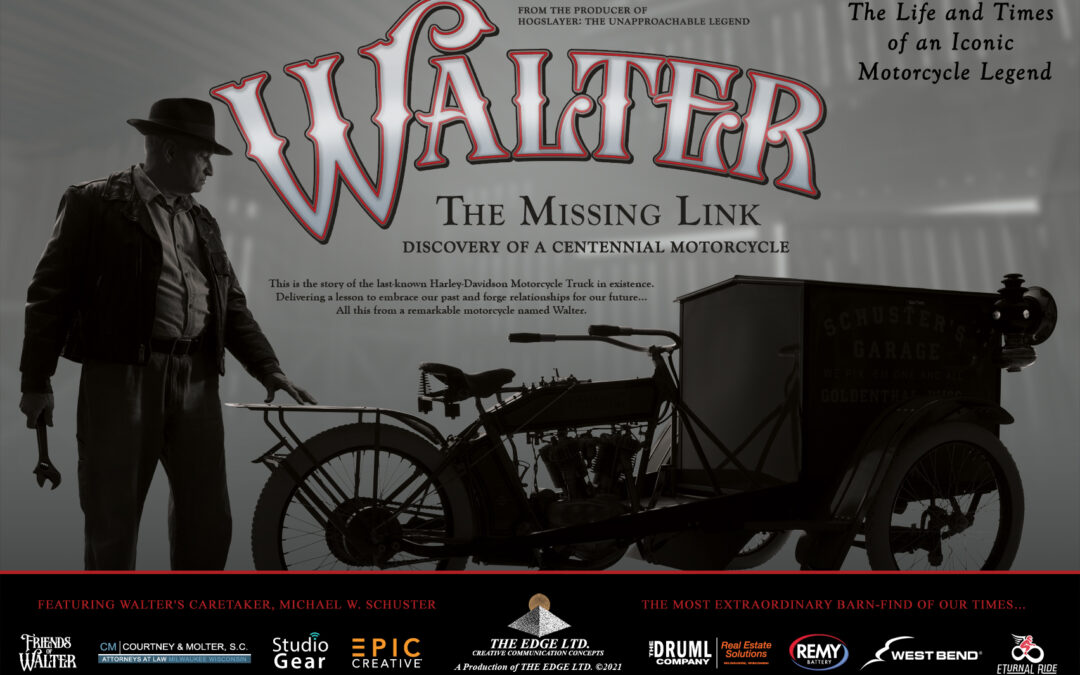
Walter: The Missing Link chronicles the life and times of a remarkable motorcycle affectionately known as Walter®
Walter is a feature-length narrative documentary featuring Walter, a 1913 Harley-Davidson Motorcycle Truck, and his former caretaker Michael W. Schuster. This is truly an extraordinary barn-find story that tracks Walter’s service mission delivering on the streets of old Milwaukee, then through forty years of desolation while stored in a horse barn, and finally his rebirth many decades later through a meticulous restoration by Ally Schuster and his grandson Michael. Walter ultimately became an acknowledged motorcycle artifact recognized as the last-known Harley-Davidson Motorcycle Truck in existence. This remarkable motorcycle’s story and the related experiences of those touched by him have delighted enthusiasts and inspired us all to embrace our past and forge relationships for our future.
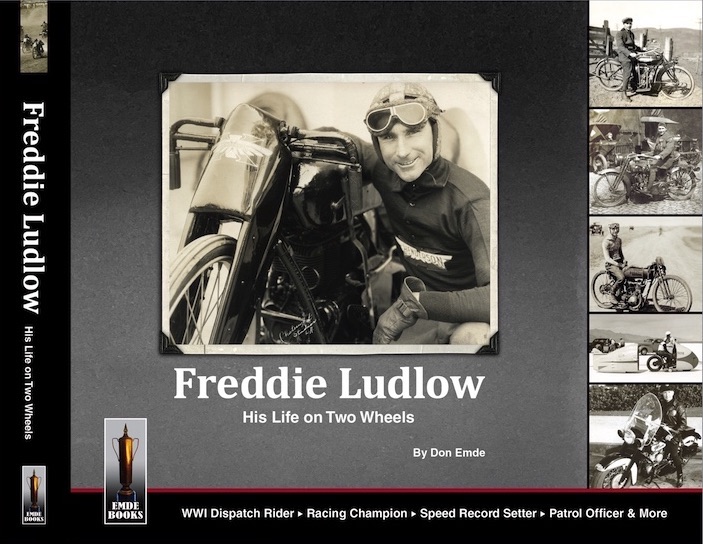
HOT OFF THE PRESS!
Freddie Ludlow. His Life on Two Wheels, by Don Emde
Back in 2020, The Speed Kings. The Rise & Fall of Motordrome Racing, by Don Emde, received the Best Book of the Year award by the Motor Press Guild. Now, you can be among the first to own a copy of his latest book, Freddie Ludlow. His Life on Two Wheels. Available now!
The seeds of the idea for this book were planted over twenty years ago when author Don Emde was entrusted with the care and ownership of a scrapbook of Freddie Ludlow, an early day motorcycle pioneer. With nearly 100 pages of the scrapbook photos organized chronologically with Ludlow’s own handwritten captions, what was obvious was that he was a man of adventure and competitive spirit, who also answered the call to serve his country.
Freddie Ludlow’s motorcycling life began as a delivery boy for Western Union on the streets of downtown Los Angeles around 1910. Local competitions followed until he enlisted in the Army and put his motorcycling experiences as a rider and mechanic to use in Europe during World War I. Upon his return home, Ludlow became one of the top motorcycle racers in the United States, rising to the level of National Champion in 1921. A few years later, his sense of service again saw him finding ways to put motorcycles to good use when he became a motor patrol officer in Pasadena, California, a job that he would have for the next thirty years.
His new “day job” didn’t mean, though, that Freddie was done raising the bar in the motorcycle sport when it came to speed and performance. Through the 1920s and ‘30s, he set numerous speed records on the hard packed sand at Daytona Beach, Florida; on the Bonneville Salt Flats, even along a stretch of public road near San Bernardino, California.
Freddie Ludlow died in 1983, but his amazing motorcycling life lives on in Freddie Ludlow. His Life on Two Wheels. It features not only his scrapbook pages but also many pages written by Don Emde filled with back stories and additional rare and historic photographs of Ludlow and many other legendary racers who were his competitors.
176 pages – Hardbound – 10 x 12 inches
Highly illustrated – 400+ photos and related images
Printed in sepia-tone throughout with retouched black & white photos from Freddie Ludlow’s scrapbook pages, plus some limited color images.
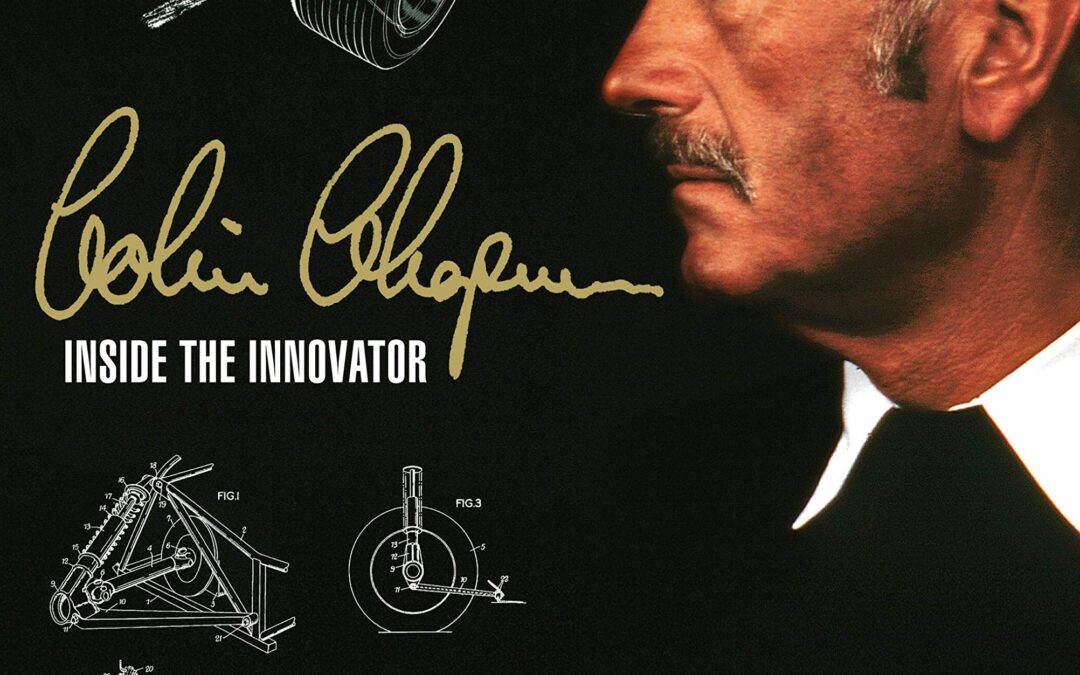
Renowned as one of the greatest creative forces in the world of the automobile, Lotus’s Colin Chapman (1928–82) left a mixed legacy. Was he an unparalleled innovator or an uninhibited exploiter of the uncredited ideas of others? In this landmark book, celebrated author Karl Ludvigsen gets to grips with the legend, digging deep beneath the skin of Chapman and his cars to explore and expose the motivations that drove this mercurial and controversial genius. Interviews with key figures in the Chapman story mesh with information from the author’s extensive archives to make this book a unique and compelling encounter between the engineer-innovator and the historian-investigator.
- Conceiving concepts: assessment of the man whom Keith Duckworth described as ‘the most brilliant conceptual engineer I’ve known’.
- Engine enterprise: recognising that he was, in his words, ‘not an engine man’, Chapman made the best of engines available to him, whether Ford 1172 side-valve, BRM H-16, Cosworth DFV V8 or Pratt & Whitney gas turbine.
- Transmission topics: this chapter moves through Lotus-designed ‘Queerbox’ transaxles, four-wheel drive, automatic clutch actuation and much more.
- Suspension sagas: from makeshift suspension ingenuity on his first Austin-based special to espousal of active suspension just before his death, Chapman gained and exploited an advanced understanding of a car’s underpinnings.
- Structure stories: Chapman’s accomplishments in this field are numerous. Best-known among them are his monocoque innovations, in glass-fibre for the Elite road car and aluminium for the F1 Type 25.
- Whittling weight: obsession with lightness was a Chapman mantra throughout his life. It contributed hugely to the success of his cars, occasionally at an expense of strength and safety that scared off some drivers.
- Aerodynamic adventures: Chapman enjoyed aerodynamics — ‘a very absorbing subject’ — and was at the forefront of major F1 developments in this area.
- Discovering downforce: early insights with wings and wedge-shaped bodies, exemplified by his Types 56 (Indycar) and 72 (F1), led ultimately to the pioneering breakthrough of traction-enhancing ground effect, which reached full flowering with the F1 Lotus 79.
- Ludvigsen gives special attention to Chapman’s exploits at Indianapolis, where he and his cars transformed the nature of America’s premier race with stunning innovations far from the safety of home.
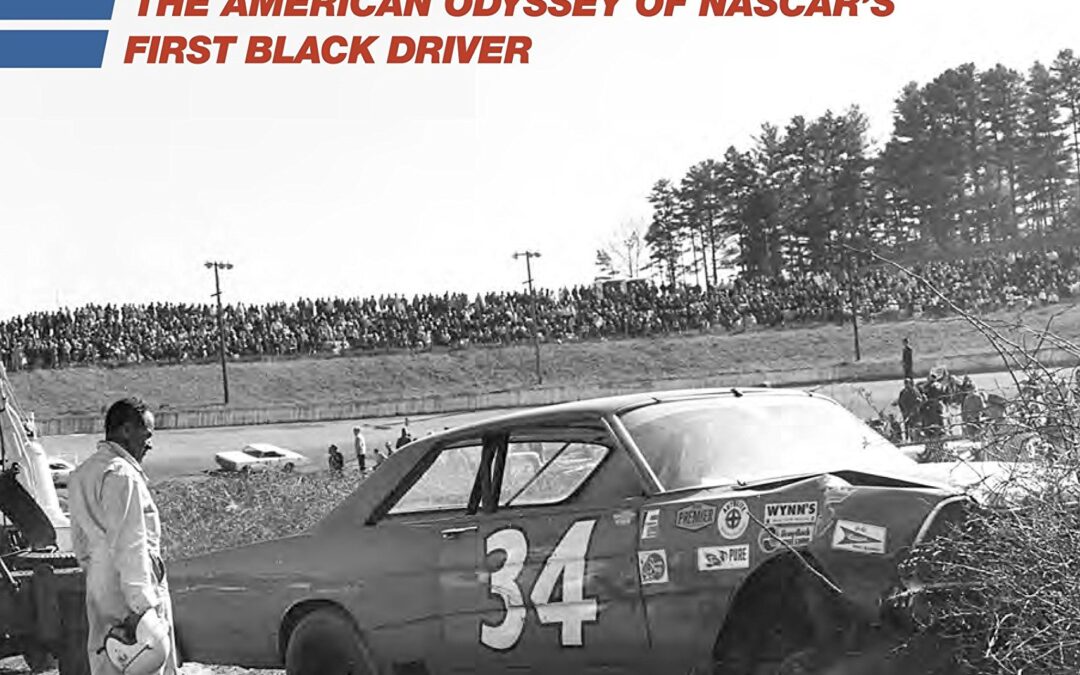
The American Odyssey of NASCAR’s First Black Driver
Hard Driving is the dramatic story of one man’s dogged determination to live the life he loved, and to compete, despite daunting obstacles, at the highest level of his sport.
Wendell Scott figured he was signing up for trouble when he became NASCAR’s version of Jackie Robinson in the segregated 1950s. Some speedways refused to let him race. “Go home, nigger,” spectators yelled. And after a bigoted promoter refused to pay him, Scott appealed directly to the sport’s founder, nascar czar Bill France Sr. France made a promise Scott would never forget – that NASCAR would never treat him with prejudice.
For the next two decades, Scott chased a dream whose fulfillment depended on France backing up that promise. Persevering through crashes, health problems, and money troubles, Scott remained convinced he had the talent to become one of NASCAR’s best.
Hard Driving documents a previously untold chapter in the history of integration, politics, and sports in America. It reveals how France, founder of the multibillion-dollar nascar empire, reneged on his pledge and allowed repeated discrimination against Scott by racing officials and other powerful figures. It details France’s alliances with leading segregationist politicians such as George Wallace, the reluctance of auto executives such as Lee Iacocca to sponsor a black driver; and the inspiring support Scott received from white drivers such as nascar champions Ned Jarrett and Richard Petty, who admired his skill and tenacity.
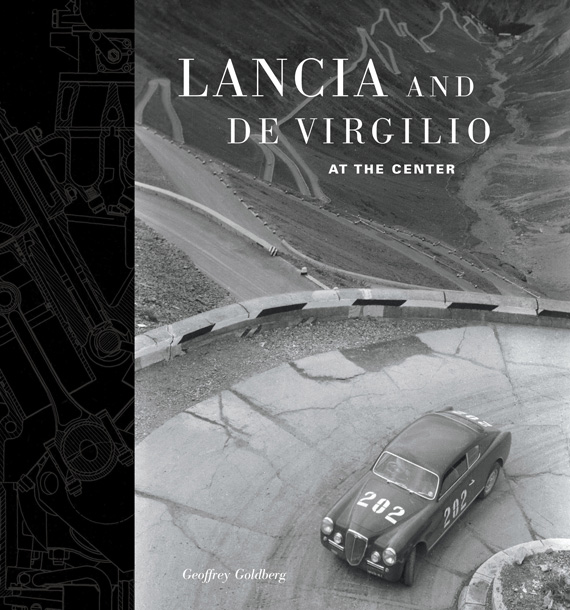
In the years following the Second World War, Lancia was the most innovative automotive company in Italy, if not in the world. The Lancia cars were technically advanced, with an elegant and competitive design on the track. For more than four decades, Francesco de Virgilio was one of the primary figures in the history of Lancia. De Virgilio entered the company as a young engineer in 1939, becoming a member of the Lancia family, when he married the niece of the founder Vincenzo Lancia, in 1947. In Lancia and de Virgilio, the author Geoffrey Goldberg examines the life and career of De Virgilio from multiple perspectives. Drawing on a large number of original documents, technical drawings and photographs from the archives of the De Virgilio family, Goldberg reveals the essential role of De Virgilio in the projects that defined Lancia during its best years in the 1940s and 50s. These include the development of the first production V6 engine, launching and improvement of the Lancia Aurelia, and the management of the short racing program of the company, which produced the classic D50 Formula One car. In addition to engineering and competitions, De Virgilio was directly involved in the events that effected the management and position of Lancia in the Italian automotive industry. In 1955, the family released its control of the company, leading to its eventual acquisition by Fiat in 1969. Through all these upheavals, De Virgilio continued to experiment and innovate, working on multiple projects, from diesel engines for trucks to the first versions of the rally car Stratos in the 1970s. Whatever the assignment, his persistent search for excellence remained a constant element defining Lancia, up to his departure from the company in 1975. Despite his technical successes and his popularity within the company, De Virgil’s contributions have been widely neglected to date.
Produced with the support of the RevS Institute for Automotive Research, Lancia and de Virgilio is the product of more than six years of meticulous research. The book is illustrated with hundreds of unpublished photographs that depict the images of Francesco de Virgilio at work, on the track and at home with his family, as well as dozens of drawings, projects and other finds. In addition to this abundance of details and information, the book, also captures the vibrant spirit of Italian, culture and society during the post-war period. Lancia and de Virgilio provides unique insight into both automotive and social history. The book was greatly appreciated by enthusiasts: it won several awards, including the Cugnot Award of the Society of Auto Historians for the best book of the year. It was also reviewed by the New York Times and the Republic, a rather exceptional event for a book on a company and its history already seventy years in the past.
This limited edition reprint is an opportunity not to be missed for those who did not secure the first edition in 2014.
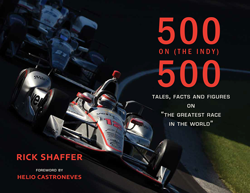
- Why is the Indianapolis Motor Speedway 2.5 miles around instead of five miles?
- Who was an Indy race winner before Ray Harroun?
- What driver had to take a streetcar home to inform his parents he had just won the Indy 500?
- How was the starting lineup determined in the years before the cars were qualified?
- Have there always been 33 starters?
Whether the distant past or modern times serves as a lure for “The Greatest Race in the World,” there are literally hundreds of fascinating, true Indy 500 tales, facts and figures.
One of the race’s most-respected journalists, Rick Shaffer, has gathered 500 of the most interesting anecdotes to come out of the intersection of 16th Street and Georgetown Road.
500 on (the Indy) 500 chronicles the famous from Chevrolet to Andretti, the obscure from William Borque (item #10, the track’s first driver fatality) to Simon Pagenaud (#496), winner 105 years after the last Frenchman to do so.
The ultimate race chronology, this book is for the curious, the scholar, the passing fan or the diehard. The depth of research is sure to entertain and illuminate aspects of the Indy 500 new to even many Indy devotees.
Hard cover, 200 color and B&W images, 280 pages.

If you have a hankering for the sand and mud, this thoroughly updated edition of The Four-Wheeler’s Bible is your ultimate resource for overland adventures, both close to home and farther afield.
Whether you are a seasoned veteran or a four-wheeling novice, you will find the information you need to maximize your enjoyment of your next off-road excursion. Author and four-wheeling experts Jim Allen and James Weber begin with a primer on emergency preparedness before combing through all considerations you should take aboard, from trail etiquette to the latest technologies. Allen and Weber explain the concepts of four-wheel-drive systems in easy-to-understand terms and go on to suggest modifications to make off-road rigs more capable, comfortable, and dependable for intended application.
This third edition is completely redesigned and updated to offer explanations of the latest electronic GPS and communications gadgetry, advice and techniques for planning and negotiating overland routes, and updates for new off-road vehicles that will help you get the most from your four-wheeling experience. With you machine up to snuff, you will be ready to hit the trails. Allen and Weber demonstrate the correct way to handle countless common off-road situations. And because everyone makes a mistake eventually, they also show how to get out of a variety of sticky situations. There’s more to the four-wheeling experience than modifying and driving a vehicle, and the authors leave no rock unturned, ensuring that you are equipped to handle nearly any trip, no matter how far into the wilderness you choose to venture.
The Four Wheeler’s Bible is an indispensable piece of gear if you’re planning to hit the trails!

This is the story of Stephen South, a young British racing driver in the Seventies who seemed set for the glory that ultimately fell instead to rival Nigel Mansell.
Where one went on to become one of the nation’s most loved characters and the World Champion in 1992, the other’s career faded to a footnote in the cruellest circumstances.
This is a multi-faceted tale of struggle, success, disappointment, controversy, the continuous battle for funding and recognition and, ultimately, heartbreak.
Famously reticent even from his early schoolboy days as a British karting champion, South now talks openly about his career with first-time author Darren Banks. Many leading figures from the world of motor racing are woven into the narrative, which traces the turbulent era of the Seventies, the trials and tribulations which only strengthened South’s quiet yet indomitable resolve, and how close he got to his dream of racing in F1 after a winter of hugely promising test work with Colin Chapman’s Lotus team in 1979.
And for the first time he discusses with chilling candour the events that saw him forced to race in the North American Can-Am sportscar series instead of F1 in 1980, the horrific accident that befell him at Trois-Rivieres in Canada, his physically and emotionally painful recovery in a hospital on the other side of the world, his eventual return home and the subsequent trauma of having to deal with a career now broken and a life permanently altered.
Those key figures recall with affection – with a couple of exceptions – their experiences of working with or racing against this vastly underrated driver who, had he been dealt a better hand by fate, would surely be remembered alongside contemporaries such as Mansell and fellow World Champion Keke Rosberg as one of the leading F1 drivers of his era.
Profusely illustrated with numerous previously unseen photographs from professional archives and personal collections, THE WAY IT WAS – The story of a British racer who was too fast to be forgotten, is a gritty tale of the darker side of a sport when it fails to deliver a racer’s just deserts.
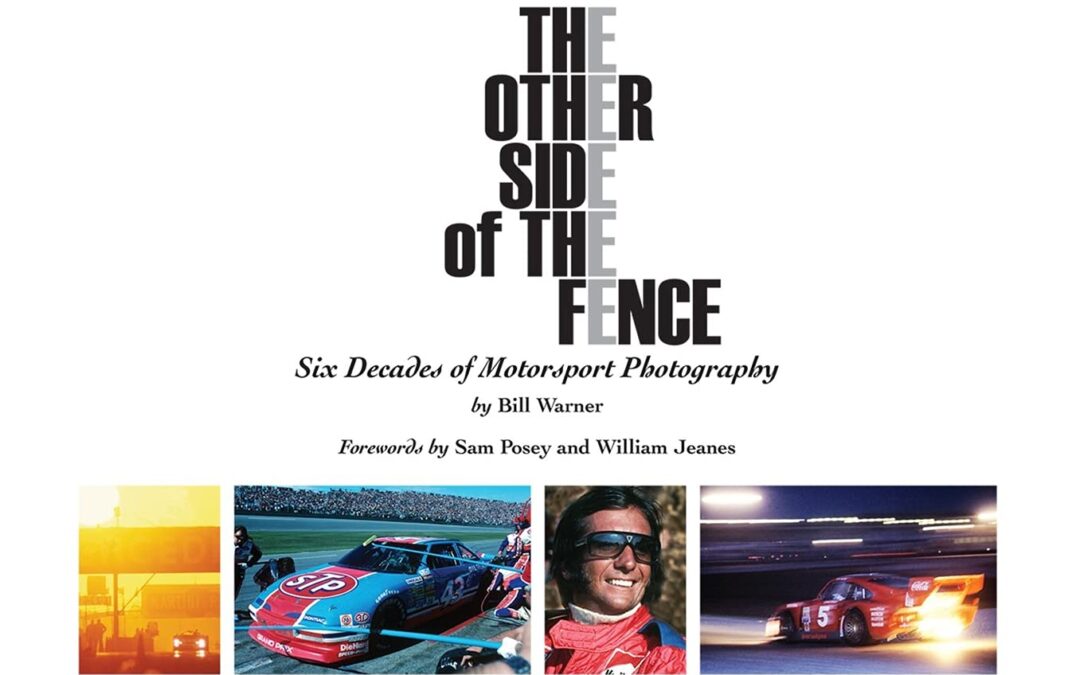
Six Decades of Motorsport Photography
The Other Side of the Fence: Six Decades of Motorsport Photography is a collection of
motorsport photographs spanning six decades shot by Bill Warner, Founder and
Chairman of The Amelia Island Concours d’Elegance. From his home base in
Jacksonville, he traveled the world photographing the drivers, cars, and racing action
from Daytona to Le Mans including Indy cars, World Championship of Makes, IMSA,
NASCAR, and Formula 1. His images have graced the pages of Road & Track, Sports
Car Graphic, The Atlantic Monthly, Automobile Year, Car and Driver, Autoweek,
Automotor und Sport (Germany), Classic and Sports Car, and Thoroughbred and
Classics (UK), and a host of other motoring publications from Australia to Eastern
Europe. He is the recipient of the Sports Car Club of America’s (SCCA) Photographer of
the Year and won recognition from the Los Angeles Art Directors and the Creative Arts
Yearbook. His work is on permanent display at The Brumos Collection and has been on
featured at the Petersen Museum and The Meadow Brook Concours d’Elegance.
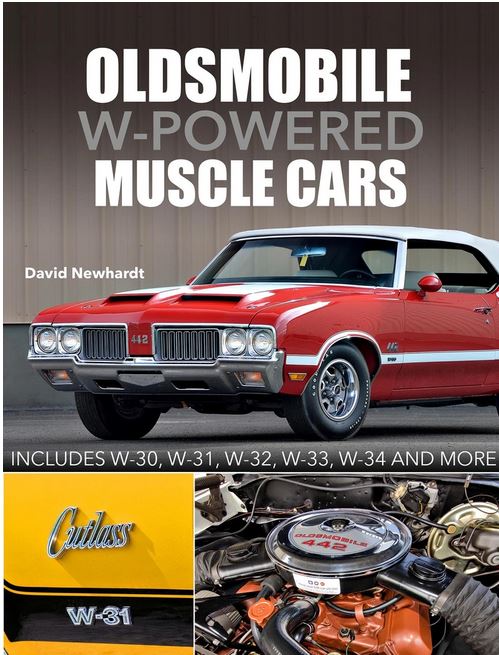
Relive Oldsmobile’s most potent muscle car offerings when the simple letter W intimidated all takers.
Oldsmobile’s foray into the developing muscle car wars of the 1960s came as little surprise to most in the automotive industry. What was surprising was that it wasn’t the first to develop it! Oldsmobile’s Rocket 88 has been viewed by some as the beginning of performance offerings from automobile manufacturers. The 4-4-2 was Oldsmobile’s volley back at the Pontiac GTO, and in 1966, Olds attempted to spike the ball home with its all-new W-30 high-performance drag racing package.
During the course of the next pair of decades, Oldsmobile offered the W-code on a host of platforms (the Cutlass, F-85, 4-4-2, Toronado, and Delta 88) with an assortment of engine packages (400, 455, and 350). As muscle cars fell by the wayside during the struggling 1970s, Oldsmobile continued to carry its flagship W-30 all the way through the 1980 model year.
This book by muscle car historian and esteemed photographer David Newhardt revisits and celebrates Oldsmobile’s legendary W-optioned performance machines. So, sit down, strap in, and let Dr. Oldsmobile do the driving.

Between 1997 and 2014, Tom Kristensen won the world’s toughest motor race, the Le Mans 24 Hours, a record nine times and finished on the podium on five more occasions. Every time his car made it to the finish, in fact, he was in the top three. It is no wonder that this great sports car driver is known as ‘Mr Le Mans’ to motorsport fans around the world.
Now retired from racing, Kristensen shares in this book his deepest personal reflections and insights from inside and outside the cockpit. He looks back on more than 30 years spent striving for perfection in racing and tells of the battles and setbacks that sometimes seemed impossible to overcome, including a terrible accident in 2007.
- Climbing the racing ladder, from karting into Formula 3 single-seaters, including championship titles in Germany (1991) and Japan (1993), then Formula 3000 and a Formula 1 testing role with Tyrrell.
- Winning as an underdog on his first visit to Le Mans, in 1997 driving an elderly Joest-run privateer Porsche in which he impressed all onlookers with a night-time charge to vanquish Porsche’s factory-entered favourite.
- His second Le Mans victory came in 2000 on his maiden drive for Audi in the R8, a car that was to become all-conquering.
- Kristensen won the next five editions of Le Mans, four times with Audi and once with Bentley (in 2003), his last victory in this sequence taking him past Jacky Ickx’s previous record at the Circuit de la Sarthe.
- His eighth win came in one of the all-time classic contests at Le Mans, in 2008, a rollercoaster of a race in which his ageing diesel-powered Audi was never expected to beat the fancied works Peugeots.
- One more victory with Audi in 2013 sealed his reputation as a true legend of Le Mans.
- His story includes exploits at other racetracks all over the world, none more prolific than Sebring, home of America’s long-established classic endurance race that Kristensen won six times.
- Personal reflections together with contributions from notable observers — including English journalists Gary Watkins and Charles Bradley — complete a truly rounded portrait of the man and his achievements.
Voted ‘Sports Book of the Year’ when originally published in Kristensen’s native Denmark, this thoughtful memoir is now available in English.
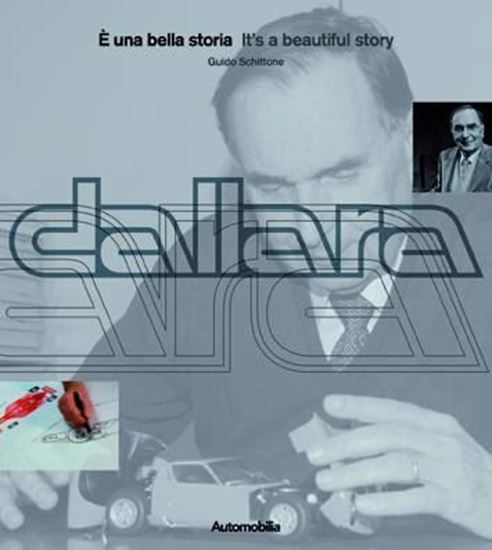
Gian Paolo Dallara’s story is a story of passion in which the vicissitudes of life interweave with those of a company which, having started life in a small garage, has become a benchmark for technological achievement in motor racing. Both man and company are inextricably linked with the little town of Varano de’ Melegari which nestles in the foothills of the Apennines 20 kilometres from Parma. Dallara and his cars have even conquered Indianapolis, the home of American motor sport and headquarters of Dallara USA. From Varano to the world: an incredible story. A beautiful story. Told by Guido Schittone, a television journalist with a love of the printed word, with the contribution of Pino Allievi, Eddie Cheever, Cesare Fiorio and testimonies of Mario Andretti, Paolo Barilla, Aldo Costa, Piero Ferrari, Dario Franchitti, Emanuele Pirro, Lorenzo Ramaciotti, Jean Todt, Frank Williams.
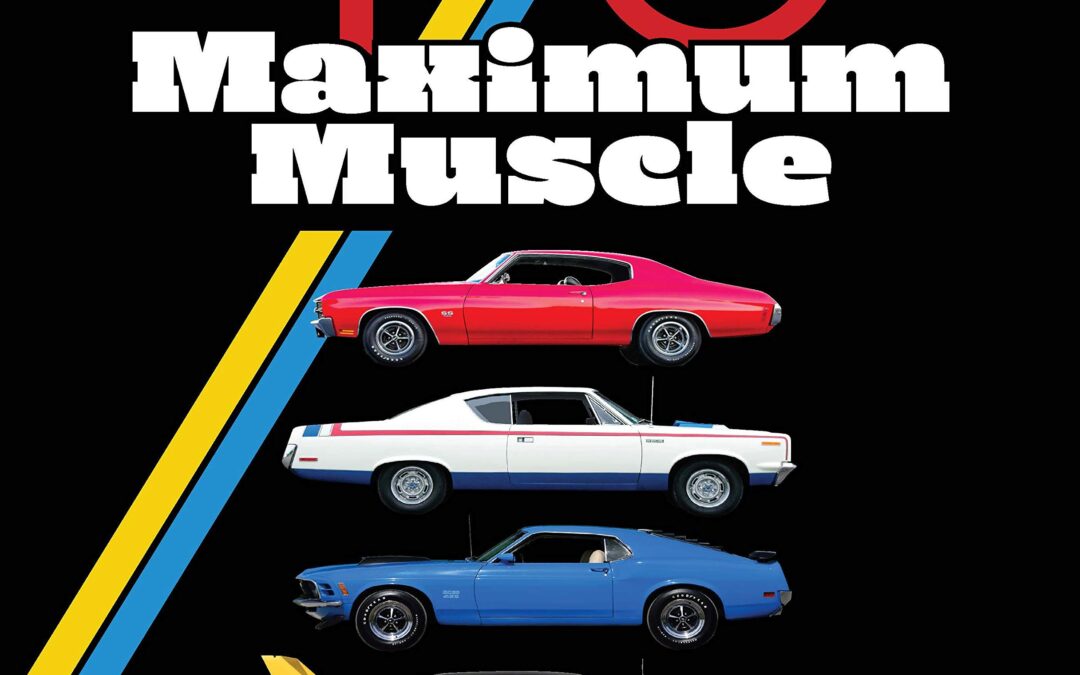
In 1970, the American muscle car was as fast and outrageous as it would ever get. But the end was nigh, and 1970 Maximum Muscle dives head-first into the storm before the calm.
Wherever you mark the beginning of the muscle car era—Oldsmobile’s 1949 Rocket 88, Chrysler’s 1951 FirePower engines, the 1964 Pontiac GTO—one thing is certain: in 1970, the era that had witnessed a parade of gloriously powerful, stylish, and brawny cars apt to make the hearts of even the most dispassionate squares go pitter-patter was sucking fumes. Gasoline shortages, skyrocketing fuel prices, insurance-industry bean counters, rising ecological concerns, and new, more fuel-efficient imports all conspired to consign the American muscle car to an ugly and unseemly denouement. Yet 1970 saw the actual zenith of the cars themselves, the year manufacturers pulled out all the stops and produced the most powerful and stunning machines the automotive world had ever seen.
1970 Maximum Muscle not only explores the factors that led to the decline of the most exciting era in the American automotive industry, it details some of the new models and model options that arguably made 1970 the climax of the muscle car era from engineering, styling, and cultural standpoints. As the war among GM, Ford, Chrysler, and AMC played out at dealerships, dragstrips, and drive-ins, ready-and-willing gearheads drove off dealer lots in potent behemoths like the Buick GSX, Oldsmobile 4-4-2, and Ford Torino Cobra. Muscle car stalwarts like the SS Chevelle, Pontiac GTO, and Plymouth ’Cuda became available with optional LS-6, Stage 1, and Hemi engines, respectively. Manufacturers ratcheted up the advertising hyperbole at the same time, offering performance packages with names like “Six-Pack,” “Ram Air,” and “Cobra Jet,” while spoilers, scoops, hood tachometers, and decal packages were de rigueur. Meanwhile, on the popular SCCA Trans Am circuit, top drivers campaigned more nimble muscle off-the-rack cars like the Camaro Z/28 and Boss 302 Mustang.
1970 Maximum Muscle is an entertaining and rollicking look at the muscle car’s peak year!
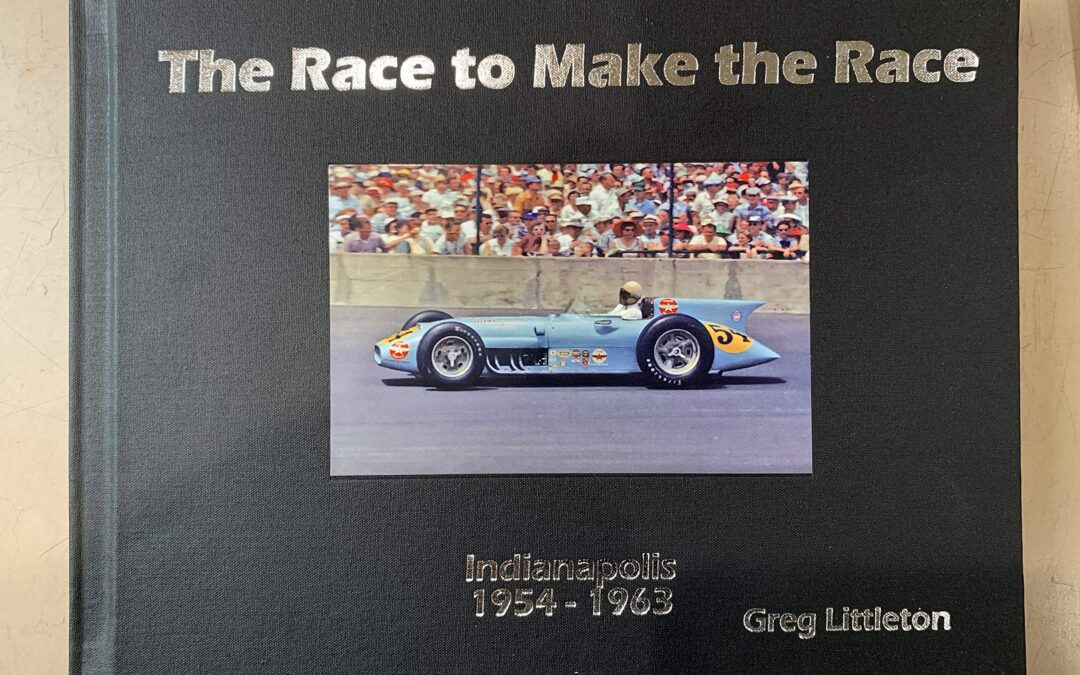
SIGNED
In his new book “The Race to Make the Race” Littleton chronicles a 10-year span (1954-1963) which was the peak roadster years at Indy and records what went on for every qualification attempt during this time period and each lap speed even if the attempt was yellow flagged. There is no mention of the races themselves as those results have been well-documented over the years.
Today’s 500 is lucky to attract 33 cars some years, but there was a time when the 500 really did have an actual Month of May and sometimes more cars went home than made the starting fields. Littleton’s book records by the actual time of day, weather conditions, attendance and all of the other happenings both on the track and in the Garage Area.
There are a lot of details in the book that you will never see anywhere else today. During the years in question the drama around the efforts to find speed just to qualify were often nearly as interesting as the actual race.
“While I was doing the Roadsters book I got the idea about doing a book on qualifications for the Indy 500,” said Littleton. “I got some qualifying information from the Speedway records when I was doing my first book. It was fun to do. I wanted to give the story on the successes and struggles each driver went through to try and make the Indianapolis 500 those years. The Bartholomew County Library was a big help in assisting me. They were able to get the microfilms from the Indiana State Library. I probably made 75 trips down to the local library to gather the information I needed.”
Littleton also mentioned two of the area’s standout racers at Indianapolis. Larry Crockett of Columbus who was the fastest rookie qualifier in 1954 and in the 500-mile race that year he ended up being the top finishing rookie over Pat O’Connor of North Vernon.
Littleton said Crockett, who died in a racing accident in Pennsylvania in 1955 right before he would have attempted to make his second Indianapolis 500, would have been a candidate to win the Indy 500.
“He was so young when he was starting out,” he said. “Nobody knows how his career would have turned out. If he had three or four years on him then I could have given you a better estimate on him. He was fast enough. There were some brave souls in 1954 and they said Larry Crockett was the best young driver in the United States.”
Like Crockett, Littleton gave his assessment on O’Connor who was killed in a first-lap accident in the 1958 race if he too could have won the Indy 500.
“Pat O’Connor definitely could have been an Indy 500 champion,” he said. “The legend of Pat O’Connor just keeps growing around here. You talk to guys and there is no doubt he was a natural. He was so smooth; everything came easy for him. He had the right head for it. He knew the days the car was good enough and the days it wasn’t.”
In documenting every lap of time trials during the 10-year span he chronicled there was one driver that stood out when writing the book was a young driver named Bob Scott in 1954.
“He had a good car in ’54 and on the fourth and final day of qualifying he was not in the show yet,” Littleton explains. “He jumped into a car that was not considered top-of-the-line equipment. He put three good laps together and they were going to be good enough to put him in the race, all he needed was one more consistent lap and he was in, but before he took the checkered flag he pulled into the pits and thus he didn’t qualify for the starting field. He apparently didn’t look at the flagman. He never did say why he pulled off.”
If Littleton had to pick a Mount Rushmore of Indy 500 champions his list would include: Bill Vukovich, A.J. Foyt, Wilbur Shaw and Al Unser Sr. Littleton also gave mention to 1963 winner Parnelli Jones.
“He was probably the least successful great race driver,” he said. “He would consistently beat Foyt in sprint cars, but he only won Indy once.”
On the sale last month of the Indianapolis Motor Speedway to Roger Penske, Littleton had this to say.
“Who else cares enough about racing and has the business acumen than Roger Penske?,” he asked. “He has everything that can make it work. Every decision he makes you may not like, but he has the best interest of the speedway in mind.”
Penske becomes the fourth owner of the track. The Hulman family had owned the track for 74 years.
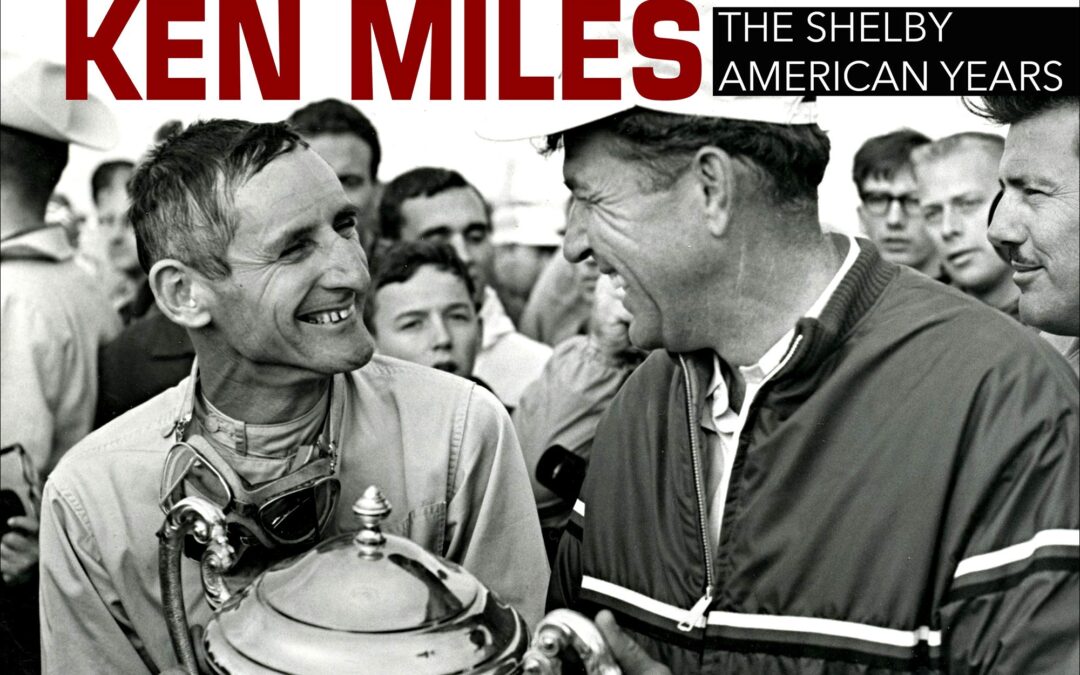
Ken Miles is one of the most famous sports car racers in history, and his time at Shelby American was the pinnacle of his career.
Ride shotgun with Ken Miles through the twists and turns of Sebring, Laguna Seca, Riverside, and Le Mans as seen through the lens of Shelby American photographer Dave Friedman!
The hiring of Ken Miles by Carroll Shelby in February 1963 initiated arguably the greatest pairing of driver/owner partnerships in the history of motorsports. Not only did Shelby hire Competition Manager Ken Miles as an accomplished road racer but also Miles brought professionalism, innovation, and a keen attribute of being able to surround himself with budding, talented individuals.
The list of race cars that Ken piloted at Shelby American is nearly unrivaled: the Shelby 289 Cobra, 390 Cobra, 427 Cobra, King Cobra, Shelby Daytona, Mustang GT350R, and Ford GT. Ken dominated the 1964 United States Road Racing Championship (USRRC) racing season by winning 8 of 10 races to secure the Manufacturers’ Championship. However, it was at Le Mans where Ken Miles became a worldwide household name.
The robbery that was the 1966 24 Hours of Le Mans is laid out in excruciatingly accurate detail as Ford royalty Carroll Shelby, Carroll Smith, Homer Perry, Leo Beebe, Charlie Agapiou, Bob Negstad, Carroll Smith, and Peter Miles recall the race and the tragedy that followed two months later.
Recapture Ken Miles’s career as told by esteemed Shelby American photographer Dave Friedman in this firsthand account titled Ken Miles: The Shelby American Years!

Learn how to build an affordable hot rod following the advice of the masters!
In How to Build Affordable Hot Rods, author and lifelong hot rod aficionado Tony Thacker takes you through the process of building a hot rod on a budget. Drawing on his own extensive experience of both buying and building rods, Thacker explores the good, the bad, and the ugly. The good was setting a land speed record at Bonneville, the bad was buying a rod from which the previous owner had “swapped out” the good engine, and the ugly–well, let’s just not go there. How to Build Affordable Hot Rods includes extensive how-to sections that cover step-by-step chassis builds for Model A, 1932, and 1936 Fords, including front- and rear-end setups. The in-depth chassis builds are complimented with sections on powertrain choices, bodywork and roof chops, wheels and tires, and wiring and paint. Also included are chapters on interiors and the all-important details that individualize any project to ensure that it stands out from the rest.
When Henry Ford introduced his beloved Model T, he unwittingly gave the average person the means to go racing. Prior to the T, racing was mostly a sport of the rich, but that changed with the Model T. Stripped of fenders and hopped up with speed parts, T speedsters ruled, and it wasn’t long before enthusiasm on the track translated to the street and the term hot rod entered the vernacular.
Of course, it didn’t need to be a Ford (and still doesn’t), but the easiest and therefore cheapest route to Hot Rod Boulevard is down the Ford road. The journey accelerated after World War II, as hot rodding boomed with the growth of speed shops, car shows, drag racing, talented and trained GIs returning home, and the launch of Hot Rod magazine to spread the gospel far and wide. More than 100 years after the original Model T, hot rodding remains alive and well in the Australasia, Europe, and (of course) its birthplace the US.
Learn from the best and get started building your affordable hot rod today!
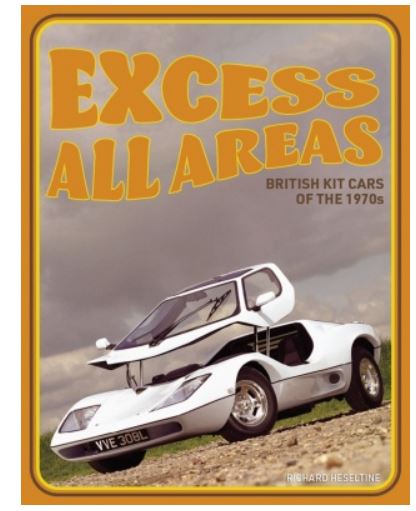
The 1970s witnessed the rebirth of the British kit car. It may have been the decade that taste forgot, but it was also a period where nothing was off limits. Would sir or madam like their car with three wheels or six? How about a windscreen that handily doubles as a door? Perchance something more along the lines of an Edwardian ‘horseless carriage’ with no doors at all? Alternatively, maybe a sports car with a roof at waist level, or even a trike made of timber? How about endless permutations of all of these things and more? Excess All Areas – British Kit Cars of the 1970s is a bountifully-illustrated celebration of homemade cars at their best – and worst.
Author Richard Heseltine is a journalist, author and biographer. A former staff member on Classic & Sports Car and Motor Sport, he has written extensively for Octane, Magneto, Classic Cars, Auto Italia, Autosport and Absolute Lotus. Richard has authored books on subjects as diverse as the British specialist sports car industry and coachbuilt Ferraris. He became a published novelist in 2019 with the release of Life Near The Edge.
“It’s a book as much about lost car culture as it is about the cars themselves” Classic Cars magazine
“My personal book of the year… a fact laden gem” Steve Hole, TKC
“This is a great fun book… right up our street in creativity, ingenuity or just plain wackiness” Jeroen Booij, Maximum Mini
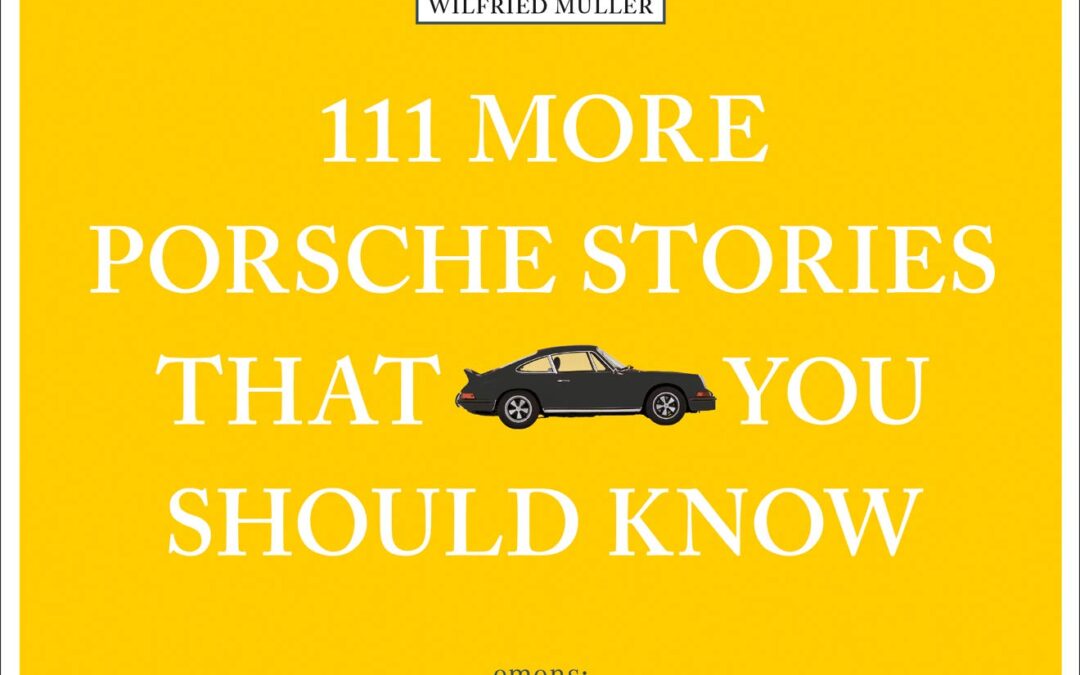
• The ultimate insider’s guide to Porsche – the stories behind the legend
• Following on from the incredible success of Volume 1
• 111 more insider stories from the dream factory
• From the Coffee Tractor to the first epic turbo victory and the e-revolution
• Fully illustrated with 111 full-page color photographs
Here are 111 more gripping Porsche Stories that afficionados of the Stuttgart brand and sports car enthusiasts should know. Wilfried Müller tells the stories of very individual characters – no matter if in the race car cockpit or on the executive floors of the Stuttgart factory, the New York showroom or the Santa Ana racing headquarters in California. Meet Mark Donohue, Dan Gurney, Alwin Springer, Max Hoffman, Jackie Oliver, Brian Redman, Stefan Bellof, Björn Waldegård, Valentin Schäffer and many more. Enjoy the anecdotes of race cars dubbed Mickey Mouse or Kangaroo, Earl Rossi’s 917 on the French Autoroute, tales from 10,000 mile rallies, Porsches that handled best when going 1.5 mph, and Porsches that were never built. Learn about the background to America’s very own version of the legendary 962 racer, the story of the 356C SC Cabriolet, and the elusive America Roadster. Not to forget the chapter about magic Porsche words, which tell the stories of Porsche Design, “RS” or the “Schüttgut”, the Porsche family’s home base and retreat in the Austrian mountains.
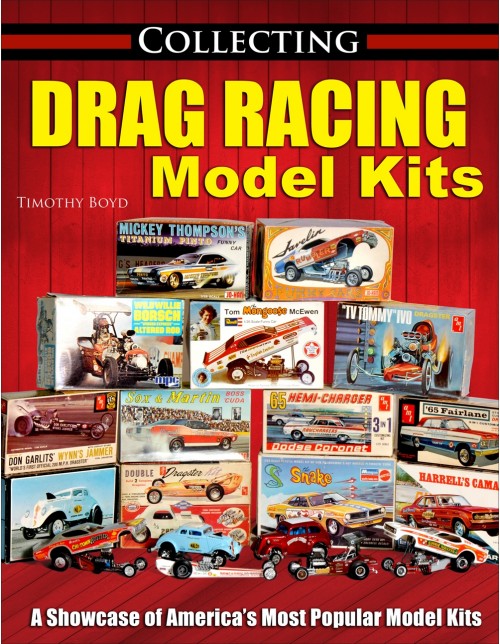
Relive the golden age of drag racing through this exhaustive volume covering the best drag racing model kits of the era.
Model expert Tim Boyd, author of Collecting Muscle Car Model Kits, turned his attention to the fantastic drag racing model kits available from the late 1950s through today. Some racing model kits were actually 3 in 1 kits, where the builder assembled the drag-race version of the car in lieu of the street or custom version. Boyd starts by covering the options, collectability, variety, availability, and value of these wonderful kits and then concentrates on the highly detailed drag racing-only kits that became available starting in the mid-1960s through today. He also shows the differences between original kits, older reproduction kits, and new reproduction kits that many enthusiasts find at swap meets and through online sources today.
Many of these great kits were from the 1960s, an era when building model kits was a widely popular, serious hobby, similar to video games today. Not only was it fun to build the kits but it was also a great way to learn about all the different race classes and categories because there wasn’t regular TV or online coverage during that era. The artwork on those kits was fantastic, and many collectors today seek original kits largely because of it.
The classes of racing covered are Gassers, Rail Dragsters, Stocks and Super Stocks, Funny Cars, Pro Stocks, Exhibition Racers, and more. Drag racing cars that never actually existed but were created by model companies are also covered.
Nostalgia drags are some of the most popular events around the country today. People can’t get enough of these old race cars that were built in an era when variety, innovation, and home building ruled the day. This book is great for modelers in general, model-kit collectors, and drag-racing fans young and old alike.
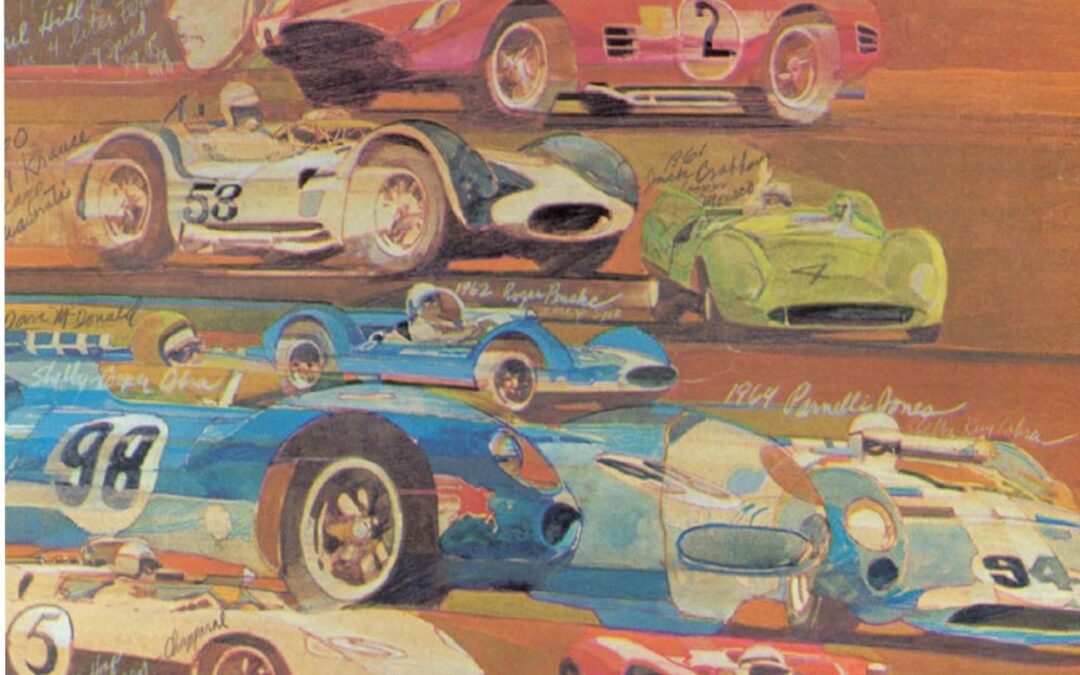
Set of 3 DVD
Marilyn was there and is still there. These are ‘through my eyes…ie home movies but all is not a set up, it’s ‘like it is’.
It ‘s the original racing days, then
John Surtees, Brian Redman, Lothar Motschenbacher
The now, is the Reunions in the same cars, new drivers and owners,…etc.






















